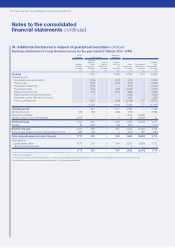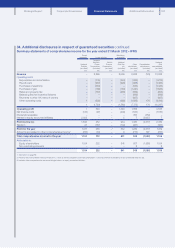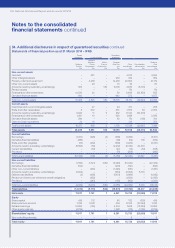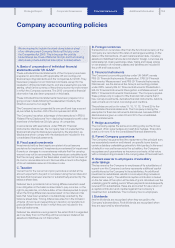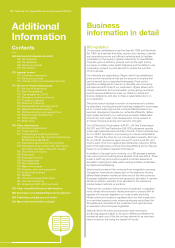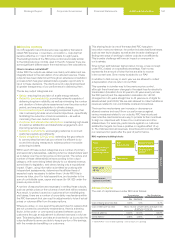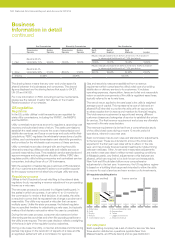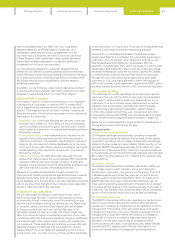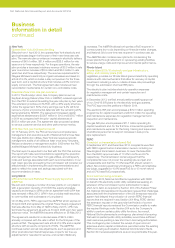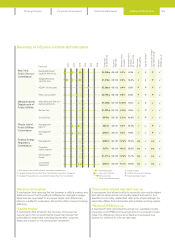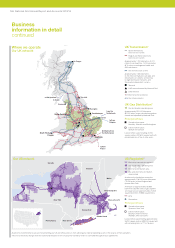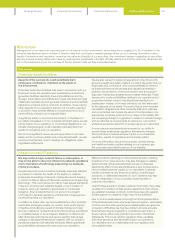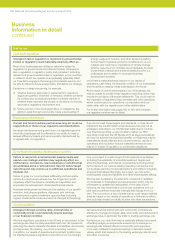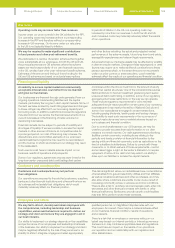National Grid 2014 Annual Report Download - page 162
Download and view the complete annual report
Please find page 162 of the 2014 National Grid annual report below. You can navigate through the pages in the report by either clicking on the pages listed below, or by using the keyword search tool below to find specific information within the annual report.
Additional
Information
Business
information in detail
Contents
160 Business information in detail
160 UK regulation
162 US regulation
166 Where we operate
167 Risk factors
170 Internal control
170 Information assurance
170 Disclosure controls
170 Internal control over nancial reporting
171 Directors’ Report disclosures
171 Articles of Association
171 Board biographies
173 Capital gains tax (CGT)
173 Change of control provisions
173 Conflicts of interest
173 Directors’ indemnity
173 Events after the reporting period
174 Material interests in shares
174 Political donations and expenditure
174 Research and development
174 Share capital
175 Share price
176 Other disclosures
176 Articles of Association
177 Code of Ethics
177 Corporate governance practices:
differences from New York Stock Exchange
(NYSE) listing standards
177 Depositary payments to the Company
178 Description of securities other than equity
securities: depositary fees and charges
178 Documents on display
178 Employees
178 Exchange controls
178 Exchange rates
179 Key milestones
179 Material contracts
179 Property, plant and equipment
179 Shareholder analysis
179 Taxation
181 The All-employee Share Plans
181 The offer and listing
181 Unresolved SEC staff comments
182 Other unaudited financial information
186 Summary consolidated financial information
188 Definitions and glossary of terms
192 Want more information or help?
UK regulation
Our licences, established under the Gas Act 1986 and Electricity
Act 1989, as amended (the Acts), require us to develop, maintain
and operate economic and efficient networks and to facilitate
competition in the supply of gas and electricity in Great Britain.
They also give us statutory powers, such as the right to bury
ourpipes or cables under public highways and the ability to use
compulsory powers to purchase land to enable the conduct
ofourbusiness.
Our networks are regulated by Ofgem, which has established
price control mechanisms that set the amount of revenue that
canbe earned by our regulated businesses. Price control
regulation is designed to ensure our interests, as a monopoly,
arebalanced with those of our customers. Ofgem allows us to
charge reasonable, but not excessive, prices giving us a future
level of revenue sufficient to meet our statutory duties and
licenceobligations, and also to make a reasonable return on
ourinvestment.
The price control includes a number of mechanisms to achieve
itsobjectives, including financial incentives designed to encourage
us to: continuously improve the cost and effectiveness of our
services; manage and operate our networks efficiently; deliver
high-quality services to our customers and wider stakeholder
community; and invest in the development of the network in
amanner that ensures long-term security of supply.
Our UK Electricity Transmission (UK ET), UK Gas Transmission
(UK GT) and UK Gas Distribution (UK GD) businesses operate
under eight separate price controls in the UK. These comprise two
for our UK ET operations, one covering our role as transmission
owner (TO) and the other for our role as system operator (SO); two
for our UK GT operations, again one as TO and one as SO; and
one for each of our four regional gas distribution networks. While
each of the eight price controls may have differing terms, they are
based on a consistent regulatory framework.
In addition to the eight price controls, our LNG storage business
has a price control covering some aspects of its operations. There
is also a tariff cap price control applied to certain elements of
domestic metering and daily meter reading activities undertaken
by National Grid Metering.
Interconnectors derive their revenues from congestion revenues.
Congestion revenues are dependent on the existence of price
differentials between markets at either end of the interconnector.
European legislation governs how capacity is allocated. It requires
all interconnection capacity to be allocated to the market via
market-based methods, ie auctions.
There are two routes for interconnector investment: a regulated
route, where interconnector developers have to comply with all
aspects of European legislation on cross-border electricity
infrastructure and receive a regulated return for their investment;
ora merchant-exempt route, where developers would face the
fullupside and downside of the investment and typically have
anexemption from European legislation.
National Grid’s UK interconnectors earn their revenue by
auctioning capacity based on the price difference between the
markets at each end of the link and are referred to as merchant
interconnectors; this being the typical UK model.
National Grid Annual Report and Accounts 2013/14160


